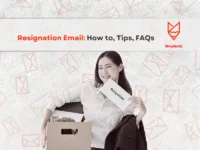When reaching out to a client or partner, your email proposal can make a significant impact. A well-crafted proposal email can clearly outline your ideas and encourage positive responses. Knowing how to format and present your proposal is key to making a strong impression.
In this article, you will find various samples of proposal emails for businesses and companies. These examples will guide you in drafting your own messages, ensuring they are professional and effective. With the right approach, you can increase your chances of closing that important deal.
Whether you’re a seasoned professional or just starting out, the right proposal email format can set you apart. You’ll learn the best practices to use, along with specific samples to fit your needs.
Basics of Proposal Emails
Proposal emails serve as a key way to communicate your ideas to potential clients or partners. Understanding their purpose, audience, and the need for clarity is essential for effective communication.
Defining the Purpose
The main purpose of a proposal email is to present your ideas and solutions to a client or stakeholder. You want to explain how your proposal meets their needs. A clear, focused email helps to grab attention and sets the tone for potential collaboration.
Your email should include the main points of your proposal, showing benefits and value. You also aim to encourage the recipient to respond, ask questions, or set up a meeting. This is where you make a strong first impression.
Understanding the Audience
Knowing your audience is crucial. Each recipient may have different interests and concerns. Research their background, business needs, and challenges. Tailor your email to address these specific points.
Use language and examples that resonate with them. Avoid using overly technical terms unless you’re certain the recipient understands. A personalized approach shows respect and increases the chance of a positive response. Adjust your tone to match your audience, whether they are formal executives or creative teams.
Importance of Clarity and Concision
Clarity and concision are vital in proposal emails. Busy professionals may not have the time to read long messages. Keeping your email clear and to the point will help ensure they grasp your main ideas quickly.
Use short paragraphs and bullet points for easy readability. Highlight key benefits or offers in bold to make them stand out. Always proofread for grammar and spelling errors since they can undermine your credibility.
In every proposal email, aim to communicate your ideas effectively while respecting your recipient’s time.
Structuring Your Proposal Email
Writing a proposal email takes careful planning. You need to capture attention right away and provide clear information. Keep your email organized for better readability.
Subject Line Essentials
Your subject line is the first thing a recipient sees. Make it clear and direct. A good subject line should include the purpose of the email and mention the proposal. For example:
- “Business Proposal: [Your Company Name] Services”
- “Proposal for [Specific Project]”
Try to keep it under 50 characters. This makes sure it displays well on mobile devices. Avoid using all caps or special characters, as this can make it seem like spam. A straightforward subject line invites the recipient to open your email.
Greeting and Introduction
Begin with a polite greeting. Use the recipient’s name if you know it. This creates a personal touch. For instance:
- “Dear [Recipient’s Name],”
- “Hello [Recipient’s Name],”
Next, introduce yourself briefly. Mention your role and the purpose of the email in the first few sentences. This establishes context. You can say something like:
- “I am [Name], and I represent [Company Name].”
- “I am reaching out to present our proposal for [Project Name].”
Make sure your introduction is friendly yet professional. Keep it to two or three sentences.
Body of the Proposal
This part is where you explain your proposal in detail. Start by outlining the purpose and benefits of your proposal. Use bullet points for clarity:
- Objective: State the main goal.
- Benefits: List advantages to the client.
- Timeline: Provide a rough schedule for the project.
This format allows quick scanning. Keep your language simple and straightforward. Avoid jargon or complex terms. Make sure each point aligns with the client’s needs. Provide any necessary details, but keep paragraphs short. Aim for no more than three sentences per paragraph.
Closing Statements
Conclude your email with a polite closing. Thank the recipient for their time and consideration. An example closing could be:
- “Thank you for considering our proposal.”
- “I look forward to your feedback.”
You should also encourage them to reach out for any questions. This shows you are approachable. A strong closing helps reinforce your professionalism. End with a formal sign-off, like:
- “Best regards,”
- “Sincerely,”
Include your name, title, and contact information below your sign-off. This makes it easy for the recipient to contact you.
Writing Effective Business Proposals
Crafting a strong business proposal is important for grabbing your client’s attention. Focus on showcasing value, clearly detailing your offer, and addressing any problems the client faces.
Highlighting Business Value
When writing your proposal, emphasize the unique value your business provides. Start with a clear statement of benefits. Use specific examples to show how your services can improve your client’s bottom line.
Consider including a brief table or list of key benefits, such as:
- Increased efficiency
- Cost savings
- Improved quality
Use language that connects your strengths to the client’s goals. Make it clear how your proposal can help them succeed. Strong value propositions can make a significant difference in securing a deal.
Detailing the Offer
In this section, explain your offer in a straightforward way. Be clear about the services or products you will provide. Include important details like timelines, deliverables, and pricing.
A well-structured bullet list can help here. For example:
- Service A: Description and outcomes.
- Service B: Description and outcomes.
- Timeline: Key milestones.
Keep the language simple and direct. This clarity helps clients understand what you are proposing. Make sure they can see how your offer aligns with their needs.
Addressing Pain Points
Identify the challenges your client is facing and address them directly. Show your understanding of their situation and demonstrate how your proposal provides solutions.
You can create a simple comparison chart to show the “before” and “after” scenarios. This visual can help clients see the changes your services will bring.
Highlight key pain points such as:
- Delays in service
- High costs
- Inefficient processes
Providing clear solutions to these issues can build trust. It assures clients you have thought through their concerns and have a plan in place to help them. By addressing these points, you position yourself as a valuable partner.
Company Proposal Specifics
When creating a company proposal, it’s important to focus on customization and integrating your branding. Tailoring your content to the specific needs of your client can enhance your chances of success.
Customizing the Proposal
Start by gathering information about the client. Understand their business goals, challenges, and industry. This allows you to create a proposal that directly addresses their specific needs.
Use a personalized greeting in the email. This small effort makes a big difference.
In the body of your proposal, mention how your services can solve their problems. Use relevant data or case studies to support your claims.
Structure your proposal clearly. Incorporate bullet points or numbered lists to outline services, timelines, and costs. This format makes it easier for clients to grasp important details quickly.
Incorporating Company Branding
Branding plays a key role in how your proposal is perceived. Ensure you use your company’s logo at the top of the email. This creates immediate recognition and establishes professionalism.
Use your brand’s color scheme and fonts throughout the document. Consistency not only enhances aesthetics but also reinforces your identity.
Include a brief section about your company. Share key facts that highlight your expertise and reliability.
Don’t forget to incorporate visuals or infographics. These elements can help clarify your points and make your proposal more engaging.
Always remember to maintain a professional tone that reflects your brand’s values. This will help create a strong impression on your potential client.
Formatting and Presentation
Your email’s format and presentation are important for making a good impression. A well-structured email helps convey your proposal clearly and professionally. Focus on layout, use of graphics, and how you handle attachments.
Professional Email Layout
Start with a clear subject line. It should include the main point of your proposal. For example, “Business Proposal for [Project Name].” Use a formal greeting, like “Dear [Client’s Name].”
Your email body should be organized into short paragraphs. Each paragraph should cover one idea or topic. Use bullet points to highlight key features or benefits. For example:
- Benefit One: Clear explanation.
- Benefit Two: Engaging description.
Finish with a polite closing statement, such as “Looking forward to your response.” Sign off with “Best regards” and your name.
Appropriate Use of Graphics
Graphics can help make your proposal more engaging. Use them sparingly and only if they add value. For example, include a small company logo to maintain brand consistency.
If you need to show data, a simple chart or graph can be effective. Make sure the graphics are relevant and easy to understand. Don’t overcrowd your email with too many images.
Always ensure that graphics are sized appropriately. Large images can slow down loading times and distract from your message.
Attachments and Supplementary Materials
It’s often helpful to attach additional documents that support your proposal. This could include a detailed project plan or a pricing sheet. Make sure to mention any attachments in your email.
Name your files clearly, like “Business_Proposal_[YourCompany][Date].pdf.” This helps the recipient find and identify your documents easily.
Before sending, double-check that all attachments are included and properly formatted. This shows attention to detail and professionalism.
Sample Business Proposal Emails
When you send a business proposal email, it’s important to use a clear format and tailor your message to the specific industry. Below are examples of standard formats and industry-specific samples to guide you.
Standard Format Samples
In a standard business proposal email, keep it organized and direct. Here’s a simple format you can follow:
Subject Line: Proposal for [Project Name]
Email Body:
- Greeting: Address the recipient by name.
- Introduction: Briefly introduce the purpose of the email.
- Proposal Overview: Present key points of your proposal. Explain what you offer and how it benefits the client.
- Call to Action: Encourage the recipient to respond with questions or set up a meeting.
- Closing: Thank them for their time and include your contact information.
Example:
Subject: Proposal for Marketing Services Dear [Client’s Name], I hope this message finds you well. I am writing to present a proposal for our marketing services that can increase your brand visibility. I would love to discuss this further and answer any questions you may have. Thank you, [Your Name] [Your Contact Information]
Industry-Specific Samples
Craft your proposal email to fit the industry you are targeting. Here are a few tailored samples:
For the Tech Industry:
Subject Line: Innovative Tech Solution Proposal
Email Body:Hi [Client’s Name],
I’m excited to present a proposal for our new software solution. This tool can streamline your workflow and enhance productivity.
Let’s connect to discuss specific features that align with your needs.
Best regards,
[Your Name]
[Your Contact Information]
For the Construction Industry:
Subject Line: Proposal for Your Upcoming Project
Email Body:
Dear [Client’s Name], Thank you for considering us for your upcoming project. Our proposal outlines a comprehensive plan that meets all requirements and ensures timely completion. I’d appreciate the opportunity to explain our approach in detail. Sincerely, [Your Name] [Your Contact Information]
Using these formats and examples, you can create effective and professional business proposal emails.
Sending Proposals to Clients
When sending proposals to clients, clear communication is key. You want to ensure that your email reflects professionalism and engages the client effectively. Attention to detail in both timing and follow-ups can improve your chances of a successful response.
A sample email for sending a proposal to a client, incorporating a professional closing phrase:
Subject: Proposal Submission for [Project Name]
Dear [Client’s Name],
I hope this message finds you well. I am excited to share our proposal for [Project Name] as discussed during our recent conversation. We have tailored this proposal to address your specific needs and objectives, and I believe it will provide significant value to your organization.
Attached to this email, you will find:
- A detailed project overview
- Timeline and milestones
- Budget estimates
- Our team’s qualifications and experience
Please take your time to review the proposal, and feel free to reach out if you have any questions or require further clarification. I am more than happy to discuss any aspects of the proposal in detail.
Thank you for considering our proposal. I look forward to your feedback and hope to collaborate on this exciting project.
Best regards,
[Name]
[Position]
[Company]
[Phone Number]
[Email Address]
This template can be customized based on your specific project details and relationship with the client.
Email Etiquette and Timing
When crafting your proposal email, begin with a clear subject line. For example, use “Business Proposal for [Project Name]”. This helps the client identify the purpose quickly.
Start your email with a polite greeting. Address the client by name for a personal touch. Keep your message concise and straight to the point. Use bullet points or short paragraphs to highlight key details.
Timing is also crucial. Send your proposal when the client is likely to be most attentive. Early in the week, such as Tuesday or Wednesday, often sees higher email engagement. Avoid sending emails during holidays or late Fridays to ensure they don’t get overlooked.
Follow-Up Procedures
After sending the proposal, give the client some time to review it. A week is a good timeframe for a first follow-up. In your follow-up email, express your interest in their thoughts on the proposal.
Keep your follow-up concise. Reference the original email and ask if they have any questions. It’s also helpful to suggest further discussion.
If you don’t receive a response after two follow-ups, consider giving it more time. People get busy, so a little patience can go a long way. Use a respectful tone throughout all communications to maintain a positive relationship.
Analysis and Revision
When you send a proposal email, receiving feedback helps you improve. Analyzing responses and making revisions based on them is vital.
Evaluating Responses
After sending your proposal email, pay close attention to the replies you receive. Look for common themes in the feedback.
- Positive Signals: If the recipient shows interest, note what they liked. This can guide future proposals.
- Constructive Criticism: Take note of any suggestions or concerns. These insights highlight areas for improvement.
Use a simple table to track responses:
Response Type Notes
Positive feedback Key points that resonated
Suggestions Areas needing more clarity
Rejections Reasons for dismissal
Collecting this information helps shape better proposals in the future.
Amending the Proposal
Once you have assessed the feedback, start making changes. Focus on specific areas that require improvement.
- Content Updates: Ensure your proposal clearly addresses any issues raised. This might mean adding details or simplifying language.
- Layout Adjustments: If someone found parts confusing, consider reorganizing sections for clarity.
A bullet list can help outline changes:
- Clarify key points.
- Add more examples or data.
- Adjust the tone as needed.
After revisions, proofread your proposal again to catch errors. A polished proposal increases your chances of success.




